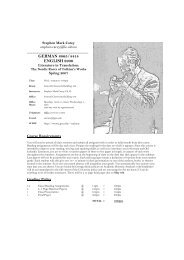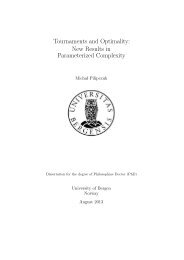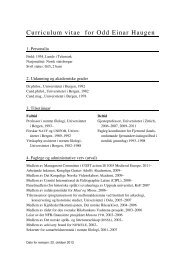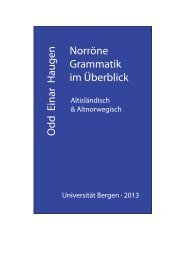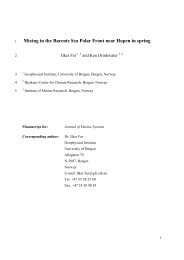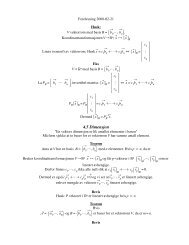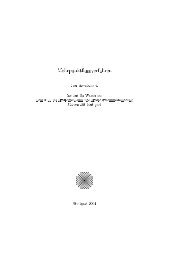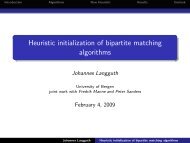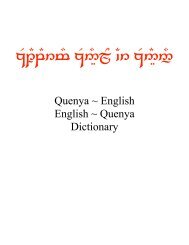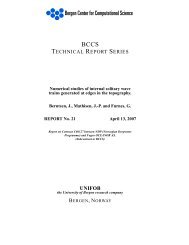Rational Curves in Calabi-Yau Threefolds
Rational Curves in Calabi-Yau Threefolds
Rational Curves in Calabi-Yau Threefolds
You also want an ePaper? Increase the reach of your titles
YUMPU automatically turns print PDFs into web optimized ePapers that Google loves.
<strong>Rational</strong> <strong>Curves</strong> <strong>in</strong> <strong>Calabi</strong>-<strong>Yau</strong> <strong>Threefolds</strong> 3929<br />
P(OP1(e1) OP1(e5)) such that P(OP1(e1) OP1(e4)) is maximally<br />
balanced given its degree (that is: e1 e4 1).<br />
A natural analogue to Step (I) <strong>in</strong> the proof of Theorem 4.3 <strong>in</strong> the<br />
previous section is: Set g ¼ e1 þ þ e4 þ 3. Us<strong>in</strong>g lattice-theoretical<br />
considerations aga<strong>in</strong>, and with certa<strong>in</strong> conditions on n, d and a, we<br />
f<strong>in</strong>d a (smooth) K3 surface S <strong>in</strong> P g with Pic S ’ ZH ZD ZG, where<br />
H is the hyperplane section class, D is the class of a smooth elliptic curve<br />
of degree 4 and C is a smooth rational curve of bidegree (d, a). In particular,<br />
S has Clifford <strong>in</strong>dex 2. (See Sec. 5.1 for the def<strong>in</strong>ition of the Clifford<br />
<strong>in</strong>dex of a K3 surface.) Let T ¼ TS be the 4-dimensional scroll <strong>in</strong> P g swept<br />
out by the l<strong>in</strong>ear spans of the divisors <strong>in</strong> jDj on S. The rational normal<br />
scroll T will be maximally balanced of degree e1 þ e2 þ e3 þ e4. In other<br />
words we should f<strong>in</strong>d an analogue of Proposition 6.2. It seems clear that<br />
we can do this.<br />
The natural analogue of Step (II) <strong>in</strong> the previous section is:<br />
Embed T ¼ P(OP1(e1) OP1(e4)) (<strong>in</strong> the obvious way) <strong>in</strong> a<br />
5-dimensional scroll T ¼ P(OP1(e1) OP1(e5)) of type (e1, ..., e5).<br />
Hence T corresponds to the divisor class H e5F <strong>in</strong> T.<br />
If g is odd, one would like to show that S is a ‘‘complete <strong>in</strong>tersection’’<br />
g 5<br />
of 2 divisors, both of type 2H 2 F restricted to T. Therefore, it is a<br />
‘‘complete <strong>in</strong>tersection’’ of three divisors Z5, Q1, Q2, the first of type<br />
g 5<br />
H e5F, and the two Qi of type 2H 2 F on T. At the moment<br />
we have no watertight argument for this.<br />
If g is even, one can show that S is a ‘‘complete <strong>in</strong>tersection’’ of 2<br />
g 4<br />
g 6<br />
divisors, of types 2H 2 F and 2H 2 F, restricted to T. Therefore,<br />
it is a ‘‘complete <strong>in</strong>tersection’’ of three divisors Z5, Q1, Q2, of types<br />
g 4<br />
g 6<br />
H e5F, 2H 2 F, and 2H 2 F on T.<br />
If one really obta<strong>in</strong>s a complete <strong>in</strong>tersection as described above, one<br />
might deform it <strong>in</strong> a rational family (i.e., parametrized by P 1 ). If S is<br />
given by equations Q1 ¼ Q2 ¼ 0, one looks at deformations<br />
or<br />
Q1 þ sQ 0 1 ¼ Q2 ¼ Z5 sBðt; u; Z1; ...; Z5Þ ¼0;<br />
Q1 ¼ Q2 þ sQ 0 2 ¼ Z5 sBðt; u; Z1; ...; Z5Þ ¼0:<br />
Here the B correspond to sections of H e5F. For ‘‘small values’’ of the<br />
parameter one would like to obta<strong>in</strong> a K3 surface with Picard group of<br />
rank 2, Clifford <strong>in</strong>dex 1 (see Sec. 5.1 for the def<strong>in</strong>ition of the Clifford<br />
<strong>in</strong>dex of a K3 surface), and no rational curve on it. For g odd, there is<br />
no essential difference between the two types of deformations. For g even,<br />
the two deformations are different.



